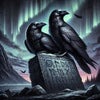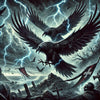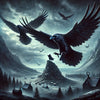The Symbolism of Huginn & Muninn in Viking Beliefs

The Symbolism of Huginn & Muninn in Viking Beliefs
Huginn and Muninn, the two ravens of Odin, are some of the most powerful and mysterious figures in Norse mythology. Unlike other animals associated with the gods, these birds were not merely companions but extensions of Odin himself, embodying his wisdom, foresight, and relentless pursuit of knowledge. Every day, they flew across the Nine Realms, observing everything that transpired before returning to whisper their discoveries into the ears of the Allfather. Their names, Huginn ("Thought") and Muninn ("Memory"), reveal their deeper meaning, symbolizing the balance between intelligence and experience, analysis and remembrance. This balance was crucial to Viking beliefs, shaping their understanding of leadership, strategy, and even the afterlife. But why were these ravens so revered? What made them such an essential part of Viking culture? To fully grasp their significance, we must explore their mythological origins, their role in Norse society, and the ways in which they continue to inspire people today.
The Mythological Role of Huginn & Muninn
The earliest references to Huginn and Muninn appear in the Poetic Edda and the Prose Edda, two of the most important sources of Norse mythology. These ancient texts describe how Odin sends out his ravens at dawn to gather intelligence from the world, awaiting their return at dusk. This act demonstrates Odin’s deep reliance on knowledge as a source of power. Unlike Thor, who wields his hammer to enforce his strength, Odin is a god of wisdom, magic, and foresight. His power comes not from brute force but from his ability to see beyond the present moment and anticipate what is to come. In this way, Huginn and Muninn represent the very foundation of Odin’s rule—the idea that true leadership is built on intelligence and awareness rather than sheer might.
Odin’s concern over their well-being is particularly telling. In one passage of the Poetic Edda, he expresses his fear that Muninn may not return. This suggests that even Odin, the most powerful of the gods, depends on memory and reflection to maintain his strength. If he were to lose Muninn—if he were to lose his connection to the past—he would be weakened. This reinforces a core Viking belief: that knowledge must be preserved and passed down to future generations. A warrior who forgets the lessons of the past is doomed to repeat mistakes, while a leader who ignores wisdom will lead his people into ruin. This emphasis on memory as a form of strength was reflected in many aspects of Viking culture, including their art, storytelling, and even their use of runes, which were believed to contain hidden knowledge. To learn more about the role of symbols in Viking tradition, check out our article on Top 5 Viking Symbols and Their Meaning.
Huginn & Muninn as Symbols of Strategy and Guidance
Beyond their role as Odin’s messengers, Huginn and Muninn also held significant meaning for Viking warriors, sailors, and leaders. The Vikings were not only fierce fighters but also expert navigators and explorers, traveling across vast distances to raid, trade, and settle in new lands. To them, knowledge of the seas, the weather, and their enemies was just as important as skill with a sword. In this sense, Huginn and Muninn represented the tools necessary for survival—foresight, adaptability, and the ability to learn from experience.
Ravens played a practical role in Viking navigation, further reinforcing their symbolic importance. When sailing in open waters, Vikings would sometimes release ravens from their ships to determine the location of land. If the bird did not return, it meant land was nearby. This practice made ravens powerful omens of direction and discovery, adding another layer to Huginn and Muninn’s meaning. Just as Odin relied on them for knowledge, Viking explorers relied on real ravens to guide them safely to new shores. This belief in ravens as symbols of guidance and protection also extended to Viking warriors, who often adorned their armor, weapons, and banners with raven imagery to invoke Odin’s wisdom and strength in battle. If you’re interested in how Viking symbols were incorporated into personal adornment, check out our article on Top 5 Viking Ring Designs and Their Meanings.
The Connection Between Huginn & Muninn and Fate
In Norse mythology, fate played a central role in the lives of both gods and mortals. The Vikings believed in the Norns, three powerful beings who wove the destiny of all living things. While fate was often seen as unavoidable, it was also believed that wisdom and knowledge could shape one’s path. This is where Huginn and Muninn come into play. As symbols of thought and memory, they represented the ability to learn from the past and make informed decisions about the future. A warrior who understood his enemy’s tactics, a leader who remembered the lessons of past conflicts, or a poet who could recall the wisdom of the ancestors—these were individuals who could, in a sense, take control of their fate.
Huginn and Muninn also had a connection to the afterlife. In many Viking sagas, ravens were seen flying over battlefields, feeding on the fallen. Because of this, they were associated with the Valkyries, the divine maidens who selected warriors to join Odin in Valhalla. Some Vikings believed that seeing a raven before battle was a sign that Odin was watching, ensuring that the bravest warriors would be rewarded in the afterlife. This dual role—both as gatherers of knowledge and as omens of fate—made Huginn and Muninn especially revered among those who sought to leave behind a lasting legacy.
Huginn & Muninn in Modern Culture
Today, Huginn and Muninn remain powerful symbols of wisdom, strategy, and insight. Their imagery can be found in Viking-inspired jewelry, tattoos, artwork, and literature, where they continue to represent the idea that true strength comes from knowledge and awareness. Many people wear Huginn and Muninn designs as a reminder to think critically, to remember the past, and to seek out wisdom in all aspects of life. Whether in the form of a pendant, a ring, or a tattoo, these ravens continue to inspire those who admire Norse mythology and Viking culture.
For those who want to carry the wisdom of Huginn and Muninn with them, Viking jewelry remains a popular choice. Ravens appear in many pieces, symbolizing intelligence, memory, and guidance. If you are interested in honoring Odin’s legendary messengers, explore our Huginn & Muninn Viking Jewelry Collection for a selection of pieces inspired by this ancient Norse legend.
Conclusion
Huginn and Muninn were far more than just Odin’s ravens—they were symbols of knowledge, foresight, and the power of thought and memory. Their presence in Viking mythology emphasized the importance of intelligence, strategic thinking, and learning from the past, values that were highly respected in Norse society. Today, their legacy continues to inspire those who seek wisdom and guidance, proving that the lessons of the past are just as valuable in the modern world. Whether you admire their mythological origins or connect with their deeper meaning, Huginn and Muninn remain timeless symbols of the pursuit of knowledge and the strength found in wisdom.




